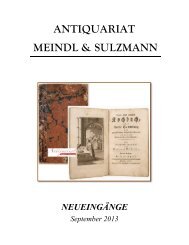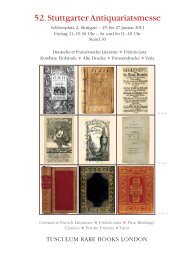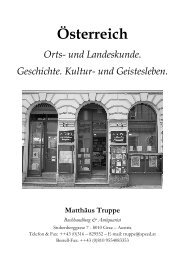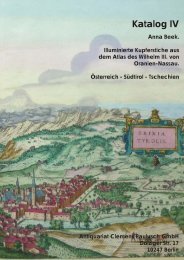Japanese Prints
Japanese Prints
Japanese Prints
You also want an ePaper? Increase the reach of your titles
YUMPU automatically turns print PDFs into web optimized ePapers that Google loves.
Henry Sotheran Limited 73<br />
Cherry Blossom<br />
The pride of Japan; the coronation of spring breaks out into pink<br />
clouds of blossoms that gradually spread over the land in early April.<br />
Stemming from ancient Shinto beliefs, cherry blossoms have been<br />
historically revered by the <strong>Japanese</strong>. cherry blossom or “sakura” is<br />
generally believed to be a corruption of the word “sakuya”<br />
(blooming) from the name of a mythical princess who is enshrined<br />
on the top of Mt fuji. Her name literally means “tree-flowersblooming-princess”,<br />
because she dropped from heaven onto a cherry<br />
tree. Ever since its close connection with Shinto, the cherry blossom<br />
has been considered the most spiritually pure of flowers. They<br />
transform the country into a fairyland which has given Japan its<br />
floral name of “The Land of the cherry-Blossom”. As symbols of<br />
the beauty and purity of life and of how quickly it fades away, they<br />
remind us all to live and enjoy life to the full.<br />
Chrysanthemum<br />
Is one of the four noble flowers (the others being the plum blossom,<br />
the orchid, and bamboo). The flower of autumn meditation and<br />
fullness, it symbolizes not only a long life but also a complete and<br />
content one. Since it blooms after summer, it is associated with<br />
aspects of autumn such as relaxation after the harvest season and<br />
periods of quiet contemplation. It can also symbolise sanctuary and<br />
refuge. The chrysanthemum’s link to longevity draws from its<br />
physical appearance. circular and symmetric with centric rays, it is<br />
a solar symbol associated with life, longevity and Japan itself. As a<br />
symbol of the nation, the emperor of Japan adopted it as his crest<br />
and it is depicted on the Imperial Seal.<br />
Cockerel<br />
A symbol of potency and power because of its propensity for<br />
fighting.<br />
Crane<br />
One of the three major mystical animals, together with the dragon<br />
and the tortoise. Its chief symbolic meaning is long life. With their<br />
lifespan of some thirty years, cranes were thought to live not just<br />
decades but thousands of years, becoming virtually synonymous<br />
with immortality. At <strong>Japanese</strong> weddings it is a symbol of loyalty.<br />
Also associated with the qualities of honour and wisdom, cranes<br />
were believed to be intermediaries between heaven and earth, a<br />
messenger of the gods to humans, thus symbolising the spiritual<br />
ability to enter a higher state of consciousness. furthermore, the<br />
crane also represents a lasting soaring spirit, health, and happiness.<br />
Their white bodies stand for purity and their red heads denote<br />
vitality.<br />
Crow<br />
The crow represents filial devotion and is also associated with<br />
chinese astrological and cosmic philosophy. It is said that a threelegged<br />
crow (yatagarasu) lives in the sun. In <strong>Japanese</strong> art crows are<br />
therefore depicted with the sun as a background. A white heron and<br />
a black crow are symbolic of day and night.<br />
Daffodil (Narcissus)<br />
represents respect and hospitality.<br />
Dahlia<br />
represents dignity and elegance.<br />
Dove<br />
Although the dove is a messenger of the God of war (Hachiman), it<br />
is also considered a symbol of peace as in the west. As messengers<br />
of Hachiman they were sent out primarily to avert conflict.<br />
Dragon<br />
As symbols of wisdom, strength, goodness and longevity, an<br />
impressive representation of a dragon can be of tremendous positive<br />
benefit to the owner. first in the hierarchy of mythical creatures in<br />
Japan, the dragon was one of the four animals symbolising the<br />
cardinal points associated with the east; the dragon stood for sunrise,<br />
spring and fertility. dragons were benevolent spirits associated with<br />
happiness and prosperity, and unlike European dragons, were kind<br />
to humans.<br />
Duck<br />
An auspicious symbol in <strong>Japanese</strong> literature and poetry, an image<br />
of a duck endows prints with an aura of good luck. They primarily<br />
represent happiness in marriage and fidelity.<br />
Falcon<br />
A symbol of regal power, as it became a favourite pastime of the<br />
aristocracy and samurai to hunt with falcons. It is also a symbol of<br />
keen endeavour and success, as well as boldness.<br />
Fans<br />
The fan stands for many things. The <strong>Japanese</strong> believe that the handle<br />
of the fan symbolises the beginning of life and the ribs are for the<br />
roads of life going out in all directions. It also symbolises friendship,<br />
respect and good wishes and is a gift that is given to people on<br />
special occasions.

















